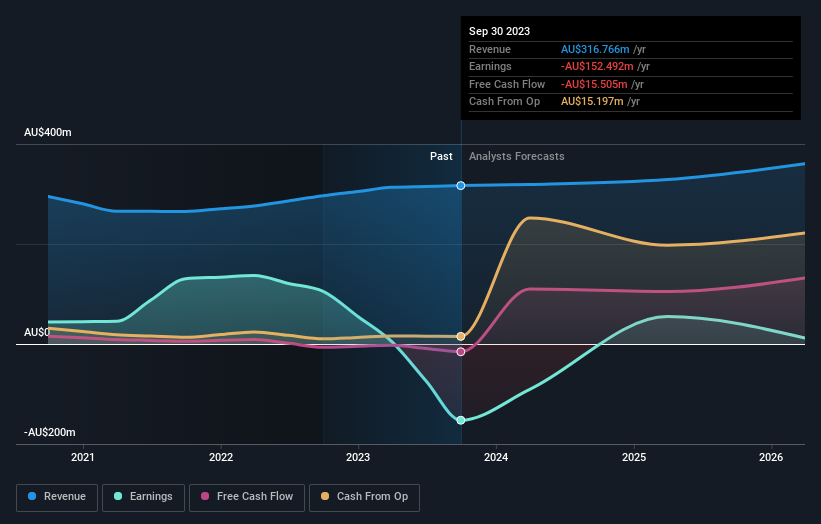72% of Australian Agricultural Company Limited (ASX:AAC) is owned by insiders, and they've been buying recently
Key Insights
Insiders appear to have a vested interest in Australian Agricultural's growth, as seen by their sizeable ownership
52% of the company is held by a single shareholder (Bryan Glinton)
To get a sense of who is truly in control of Australian Agricultural Company Limited (ASX:AAC), it is important to understand the ownership structure of the business. The group holding the most number of shares in the company, around 72% to be precise, is individual insiders. Put another way, the group faces the maximum upside potential (or downside risk).
Notably, insiders have bought shares recently. This could signal that stock prices could go up and insiders are here for it.
Let's take a closer look to see what the different types of shareholders can tell us about Australian Agricultural.
Check out our latest analysis for Australian Agricultural
What Does The Institutional Ownership Tell Us About Australian Agricultural?
Institutional investors commonly compare their own returns to the returns of a commonly followed index. So they generally do consider buying larger companies that are included in the relevant benchmark index.
Australian Agricultural already has institutions on the share registry. Indeed, they own a respectable stake in the company. This implies the analysts working for those institutions have looked at the stock and they like it. But just like anyone else, they could be wrong. If multiple institutions change their view on a stock at the same time, you could see the share price drop fast. It's therefore worth looking at Australian Agricultural's earnings history below. Of course, the future is what really matters.
Hedge funds don't have many shares in Australian Agricultural. Looking at our data, we can see that the largest shareholder is Bryan Glinton with 52% of shares outstanding. This implies that they have majority interest control of the future of the company. With 18% and 1.9% of the shares outstanding respectively, John Andrew Forrest and The Vanguard Group, Inc. are the second and third largest shareholders.
Researching institutional ownership is a good way to gauge and filter a stock's expected performance. The same can be achieved by studying analyst sentiments. There is some analyst coverage of the stock, but it could still become more well known, with time.
Insider Ownership Of Australian Agricultural
The definition of company insiders can be subjective and does vary between jurisdictions. Our data reflects individual insiders, capturing board members at the very least. The company management answer to the board and the latter should represent the interests of shareholders. Notably, sometimes top-level managers are on the board themselves.
Insider ownership is positive when it signals leadership are thinking like the true owners of the company. However, high insider ownership can also give immense power to a small group within the company. This can be negative in some circumstances.
Our most recent data indicates that insiders own the majority of Australian Agricultural Company Limited. This means they can collectively make decisions for the company. So they have a AU$612m stake in this AU$853m business. It is good to see this level of investment. You can check here to see if those insiders have been buying recently.
General Public Ownership
With a 22% ownership, the general public, mostly comprising of individual investors, have some degree of sway over Australian Agricultural. While this size of ownership may not be enough to sway a policy decision in their favour, they can still make a collective impact on company policies.
Next Steps:
It's always worth thinking about the different groups who own shares in a company. But to understand Australian Agricultural better, we need to consider many other factors.
I like to dive deeper into how a company has performed in the past. You can access this interactive graph of past earnings, revenue and cash flow, for free.
Ultimately the future is most important. You can access this free report on analyst forecasts for the company.
NB: Figures in this article are calculated using data from the last twelve months, which refer to the 12-month period ending on the last date of the month the financial statement is dated. This may not be consistent with full year annual report figures.
Have feedback on this article? Concerned about the content? Get in touch with us directly. Alternatively, email editorial-team (at) simplywallst.com.
This article by Simply Wall St is general in nature. We provide commentary based on historical data and analyst forecasts only using an unbiased methodology and our articles are not intended to be financial advice. It does not constitute a recommendation to buy or sell any stock, and does not take account of your objectives, or your financial situation. We aim to bring you long-term focused analysis driven by fundamental data. Note that our analysis may not factor in the latest price-sensitive company announcements or qualitative material. Simply Wall St has no position in any stocks mentioned.


